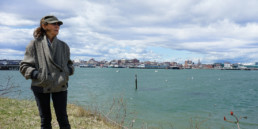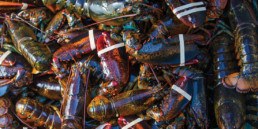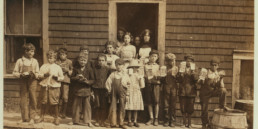In It For the Long Haul
To many residents and visitors alike, summer on a Maine island means one thing above all others: that most wonderful of culinary and sensory experiences—a Maine lobster dinner—succulent white meat dripping with drawn butter, served near the ocean.
While finding the perfect spot to enjoy a lobster, visitors may stroll along the edges of Maine’s harbors while admiring the sun dancing on a bay dotted with multicolored lobster buoys, rimmed by docks piled high with rectangular traps and filled with scores of lobster boats.
It’s a beautiful sight that lives on in memory and draws travelers back to Maine by the millions. Few visitors realize that behind the idyllic scene lies an increasingly complicated industry, or that many of the harvesters who provide the lobster, the local color, and the memories are struggling to keep their businesses afloat.
Lobster is Maine’s most valuable fishery, and Maine has plenty of lobsters, so landings are not the issue. But the fishery has been faced with a bewildering array of challenges during the past few years—challenges that in a different industry might have driven people to seek another line of work. Especially the young people. But young Maine lobstermen don’t appear to be abandoning the fishery; rather, most seem determined to stick it out at all costs.
On the other hand, younger people—the 18- to 40-year-olds—are not as well-represented in the fishery these days. Only a tiny percentage of young people who held student licenses in recent years went on to acquire commercial licenses. For that, Dave Cousens, president of the Maine Lobstermen’s Association (MLA), has a theory. He believes young people who considered getting into the fishery, from 2005 on, bumped into the low prices and high costs that still plague the fishery today.
“In the late 1990s, lobstering was pretty profitable. Kids could come out of high school and make good money. After 2005, it changed. If they didn’t own stuff, if they didn’t have assets, they really couldn’t make enough money,” said Cousens. “They need boats, a house, a truck. They needed a lot of assets, and the money just wasn’t there. After 2005, kids went out fishing and the money was horrible, so very few were staying in.”
On the other hand, if the young people came from fishing families, they were more likely to get in and stay in. “They had an advantage—their families probably helped with gear and other stuff,” said Cousens. “I think some kids also have a romantic view of lobstering . . . then they get their student licenses, go out for a while, and get a different view,” he added. “I see few kids in that generation who like physical work. They’re used to computers. But if they’re brought up doing the work, they know what to expect.”
Themes emerge when young fishermen speak of their work. They all cite the same reasons for staying in the business: They love being on the water; they love being their own boss; and they love the anticipation of harvesting, and the fact that every day is different, with different problems to solve.

NATHANIEL LANE, 24, who fishes out of Sunshine, a tiny community on Deer Isle, wasn’t brought up in the lobstering life, but took to it quickly. He started fishing at age 10. His father isn’t a fisherman, but Nathaniel went out with a family friend and soon got five traps of his own, fishing out of a small open boat that had belonged to his late grandfather, Fred Heanssler, who was a lobsterman until he was 50, and quit to found Heanssler Oil Co.
“I just caught the bug and focused on building up my gang of traps,” said Lane. “When I was in eighth grade, I had 150 traps.”
Lane’s father was a boatbuilder, now a house builder, who built an 18-foot open wood-and-fiberglass lobster boat for him. “I called it the price is right, because the labor was free,” he said. In junior high, he bought a 30-foot lobster boat called rise and shine that needed lots of work. After extensive renovations, with his dad’s help, he fished that boat for five years, building up to 600 traps.
When he went off to Eastern Nazarene College in Quincy, Massachusetts, he fished alone summers to pay his tuition. He received his business management degree in 2011, but never planned to do anything but fish. In his senior year, he bought another used wooden boat, fairwind, a 37-footer built by Neil MacKay in Prince Edward Island.
“I’m not afraid of wooden boats, or the maintenance,” said Lane. “Older fishermen say they’re more comfortable and slower to respond to weather. I think the next trend among younger fishermen will be getting wooden boats. I plan to continue as long as it’s viable or I can do it,” he said. “As much as it looks like I’m not using my degree, I am. All the decisions I have to make—figuring out my profit margin and expenses—I’m a lot more aware of the business end than I was before I went to college. Before it was just ‘Let’s go fishing.’ ”
Lane admits he’s an optimist by nature, but says he’s also not blind to reality. “A lot of fishermen are optimists, even though I hear a lot of complaints,” he said. “I always say if I listened to other fishermen, I’d never set a trap. But your best information is your own traps coming aboard your own boat. It takes a lot to get into it and years to build your business, so it’s hard to walk away from it.
“You have to watch your bait bill and expenditures,” Lane added, “but if a boat here is doing an average of 1,000 pounds, a boat in Casco Bay might be doing 500 pounds, and that’s a big concern.” Downeast Maine also offers a lot less in the way of alternative work opportunities than southern Maine, so young fishermen who want to stay have to succeed.
ZACH “BUOY” WHITENER, 26, of Long Island in Casco Bay, decided to embark on a career in research instead, after nearly a lifetime of lobstering. Like so many, he also started at the age of 10, but since his family wasn’t a fishing family, he was on his own. He used cast-off traps—wood or wire, whatever he could find—fishing from a rectangular boat he rescued when another islander was throwing it away.
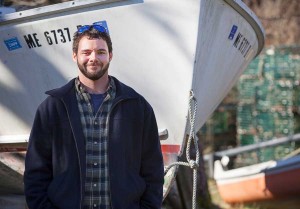
“I called it five tomatoes because I gave him five tomatoes for it,” Whitener said. “I cut the traps in half because they were too big for me. I had that boat for two years.”
In fifth grade, he appeared on a popular public television kids’ show of the time called Zoom, rowing his boat and hauling his traps.
Neighbors helped him build the next boat, a 14-foot rowboat he kept for a couple more years, until he graduated to a bigger one, a skiff he bought in South Thomaston. After that came a 23-foot vessel from Cape Elizabeth. He might have felt the lure of research anyway, but a wrist injured while playing rugby in his sophomore year of high school required surgery that didn’t quite work. A pin still floats around in there, causing pain when he hauls traps.
“I decided to go to the Cape Cod Commercial Hook Fishermen’s Association and be an observer for a summer as an independent contractor,” said Whitener. While earning a degree from Brown University in anthropology, he continued observing out of Chatham, Massachusetts, for five summers, “mostly counting discards.” After graduation he was hired on a grant for two years to do research on alewives at Portland’s Gulf of Maine Research Institute (GMRI).
When the grant ran out, he moved on to the University of the Virgin Islands for a master’s degree in marine studies and the environment, mostly completed now. “I wasn’t really qualified for the job, so I needed more education. I was a scientist by occupation but not education.” After finishing his course work, he took another job with GMRI.
“Lobstering is a surprise. It’s like opening Christmas presents all day long,” said Whitener. “The way it used to be, the more you worked, the more you earned. You got out what you put in, but not anymore. I just really liked research. It takes a long time to answer questions, and you end up with more questions.” He compares research to lobstering in at least one aspect: “It’s problem-solving and figuring out what to do.
“I love lobstering, but I knew I wanted something more,” added Whitener. “It would have been a much harder decision if my wrist was okay.” But, he said, “I still have the boat.”
BEN LOVELL, 25, comes from the Penobscot Bay island of North Haven, where most of his friends are lobstermen. His mother’s a teacher and his dad is a finish carpenter who also taught special education. He didn’t go lobstering at an early age, but tried it for two seasons after graduation from Bowdoin College in 2010.

“I got a call that there was an opening for a sternman,” said Lovell. “I had no experience; I was a total greenhorn when I went out the first day. I had been around it but never did it. It’s challenging. You get to the end of the day and you know you did something. It’s solid manual labor and I enjoyed it. There was a moment when I thought I could be a sternman for quite a while. I never wanted to be a captain and get my own traps, but toward the end I had trouble with my hands, so it was difficult,” Lovell explained.
The lobstering paychecks allowed him to move to Brooklyn, New York, where he lives now and works for Play-Well TEKnologies in an after-school program, teaching young kids engineering by using Legos. Although his history degree with a minor in teaching didn’t prepare him to teach engineering, he said, “I always played with Legos, so it’s not too tricky!
“The kind of knowledge and capability lobstermen have to have—to read the bottom, to know what’s going on out there—it’s something only certain people can do long-term. It’s a die-hard commitment.
“My close friends are pretty stubborn, and they love lobstering,” Lovell said. “Most of my friends are still sternmen. It’s so hard. It takes a lot of commitment to get your own boat and license. The last season the price was pretty terrible, but they’re in it for the long run.”
Young people who choose to continue lobstering clearly will have to adapt to changing conditions, said Bob Baines, longtime Spruce Head fisherman and MLA board member. He doesn’t expect a lot of young fishermen to flee the industry because of tough times. “No one wants to get out. It’s hard, after you’ve worked for yourself, to go and work for someone else, and the kids are more open to new ideas than us older guys,” said Baines. “They’re a little more aware.”
DILLAN CUSHMAN, 23, fishes out of Port Clyde from his 35-foot fiberglass boat, chasin’ crustacean. His father Dennis is a lobsterman. His uncle Gerry serves on the MLA board of directors. To say the Cushmans are an old fishing family is an understatement.
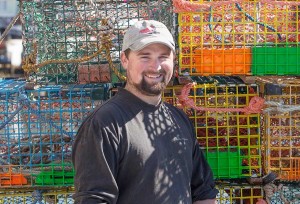
He, like so many, started with his dad at age 10. He went through the required apprenticeship program, also with his dad. Like most of the other dedicated young harvesters, he was going on his own from a skiff by age 14. At 15, Cushman bought a 34-foot Jonesporter, then a 34-foot Duffy, and finally, his latest one.
“I guess we do things differently compared to what it used to be,” said Cushman. “I have to work a lot harder to earn what I get. When I was a kid, the family would take a weekend off during the season and go camping. We can’t do that anymore. Since I’ve been going hard at it, I’ve never seen a good year for prices.”
His fuel bills are particularly high because he chooses to go offshore, chasing Homarus americanus as they move farther out in the fall.
“Not a lot of Port Clyde guys went offshore in the old days, but now the lobsters are moving farther out,” so most of the town’s younger fishermen have federal permits to go offshore, said Cushman. “The price this year was so low—you have to go a little harder if you want to make a living. For the old guys, it was a big thing when the price went under $4, then under $3. Every year it’s different, and last season was definitely a change.”
He plans to do whatever it takes to remain in the lobster fishery, however. “I think I’ll be able to stay in. I think the only thing that helped us this year was the amount of lobsters we caught, so it kind of averaged out, but if it keeps up this way, it will be a lot harder for people. I’m trying to pay everything off, just in case.”
An issue that emerged last season was “shrink,” or the death of a higher-than-usual percentage of lobsters in pounds or retail tanks soon after sale. This is due in part to another change to Maine’s fishery—the unpredictability of “shedders,” or lobsters whose shells are soft because they’ve just molted. Weather has a lot to do with it, said Cushman. “Lobsters are shedding earlier. Last year it was April. This year we had a cold winter, so maybe things will switch around with colder water.”
Shedders used to occur primarily in certain months, but now 90 percent of Maine’s catch during most of the year is shedders, according to statistics revealed at the Maine Fishermen’s Forum in March 2013. June, July, and August of 2012 saw the highest landings of any month previously recorded. Each month was higher than the one before. Dealers and pounds were overwhelmed, and most of the lobsters were the more-vulnerable shedders, so the MLA plans to teach harvesters better handling techniques in an attempt to reduce shrink.
IN THE COUSENS FAMILY, from South Thomaston, sons know what to expect from fishing. Like many Maine harvesters, Dave Cousens comes from a fishing family. He grew up on a lobster boat, fishing with his dad. His sons—Sam, Andy, and Alex—grew up on his lobster boat, and they’re still fishing out of South Thomaston, from their own boats. And they will be fishing until either hell freezes over or something else forces them out.

“I loved it all along. I never really wanted to do anything else,” said Sam Cousens, 19, the youngest of the three Cousens boys. “It’s difficult these days because the price sucks. We don’t make the money for the work we do.” Fortunately for Sam, he doesn’t yet need to pay for one of those assets his father listed, as he still lives at home with his folks.
Sam started at age 10, fishing with his dad. By the age of 12, he had purchased his own skiff and was hauling 20 traps on weekends and summers. This summer he will fish 800 traps from his vessel hauladay, named by his mother, Lori. “When I started out, it was good days, but I was fishing for my dad, earning a flat rate. Now the money’s just not that good.”
That’s one of the major problems harvesters face today. The cost of everything in the lobster fishery is going up but the prices are not; in fact, they’ve gone down—a lot.
“In 1996, my bait and fuel cost $7,500,” Dave Cousens explained. “In 2012, to pull the same amount of traps, fuel and bait cost $43,000. Last year, we got a $2.87 average price. In 2005, we got $4.19. We lost almost $2.00.” Landings for 2012 reached an all-time high of 123.3 million pounds, an increase of more than 18 million pounds over 2011, which was the first time landings had ever topped 100 million pounds.
But the price lobstermen earned for their catch was the lowest in 18 years. The catch’s dockside value was $331 million, or $3.7 million less than 2011’s $334.7 million. By contrast, in 2005, the industry landed 70 million pounds valued at $320 million. The average price per pound a lobsterman received in 2011 was $3.19, the second lowest of the past 10 years. In 2008, it averaged $2.93, the lowest since 1998.
When the cost of a gallon of fuel well exceeds the price harvesters are paid for a pound of lobster, as it does now, the profit they need in order to make it through the winter just isn’t there. Some only break even. Along with fuel, the cost of bait keeps rising, and its availability is worrisome.
But for some, the lure of fishing remains strong in spite of the known obstacles.
“I went to college for one semester. It just wasn’t for me. I fished weekends when I was in school, and I knew what I wanted to do,” said Andy Cousens, 27, the middle one of the three brothers. Like Sam and older brother, Alex, 29, Andy was fishing on his father’s boat by age 10, along with his older brother.
“When I was 12, I started going with my older brother, Alex, who was 14. We bought a 14-foot flat-bottom wooden skiff. We were hauling 20 traps together,” said Andy. “We did that for a couple of years, then the two of us got a 32-foot powerboat together, the sea wolf. Freshman year in high school, I bought that boat outright and got a sternman. I kept that boat for four years. When I finished high school, I bought my grandfather’s boat and called it happy daze.”
That grandfather is Nate Cousens, retired lobsterman. Nate’s house is on one side of Dave’s house; mother Lori’s parents live on the other side (and her father fishes). Andy lives behind his parents’ house, and Sam lives with them, while Alex is just down the road a bit. Lori earned a James Beard culinary award a few years back for the lobster rolls she sells at their Waterman’s Beach restaurant across the street. It helps that they all get along. A family compound such as this used to be common in fishing towns, and the tradition is still alive. The Cousens compound is not the only one like it in the small community of South Thomaston.
A couple of years ago Andy bought his first fiberglass boat, a 38-foot vessel he calls sea time. “I loved the wooden boat,” he said, “but this is easier.” So, he’s independent now, dealing with all the issues facing lobstermen today. “You have to be good with money and crunch the numbers to know what you need to get through the year,” Andy cautions. “It’s a lot of work, planning and saving, but I’m making it.”
A few groups in Maine plan to try to expand the base of buyers in case the huge catches continue. Marketing and quality-handling techniques emerged as two major themes from 16 meetings held along the coast in 2012, as Department of Marine Resources (DMR) staff and industry participants struggled to come up with solutions to the challenges of the past several years.
“Definitely in the future I expect to explore marketing or be my own dealer or something. I have the background for that now. No way I’m tempted not to fish,” Lane said. “The call is too strong.”
Lane’s not alone in thinking marketing may be the key to the future for the younger harvesters. In Portland in 2004, two 20-something brothers, John and Brendan Ready, started “Catch a Piece of Maine,” selling the contents of a lobster trap for the season for a fixed price. Buyers may receive up to 15 lobster dinners shipped anywhere in the country, and may watch “their” trap being hauled via an underwater video camera. Their business, Ready Seafood Co., has expanded to include wholesale and retail sales of fresh and frozen lobster products.
“Trying to get a business going shipping lobsters online is definitely something I see myself doing in the future, with my brothers,” said Andy Cousens.
The entire industry is seeking solutions to the current challenges. As Dave Cousens said, “We’ve had 16 meetings with the DMR to see what people wanted to do—lower the trap limit, put on a temporary gauge increase, have a three-day week early in the season—a lot of ideas, but no consensus. Grade lobsters? Diminish shrink? Try better handling practices? The MLA will push better handling practices this year,” Cousens noted. “Handle them like eggs, don’t throw them, don’t put a sick lobster in the tank,” he said, along with other precautions.
But the hope for the lobster industry’s future lies with its youth, said Cousens: “The younger ones have to be more innovative.”


